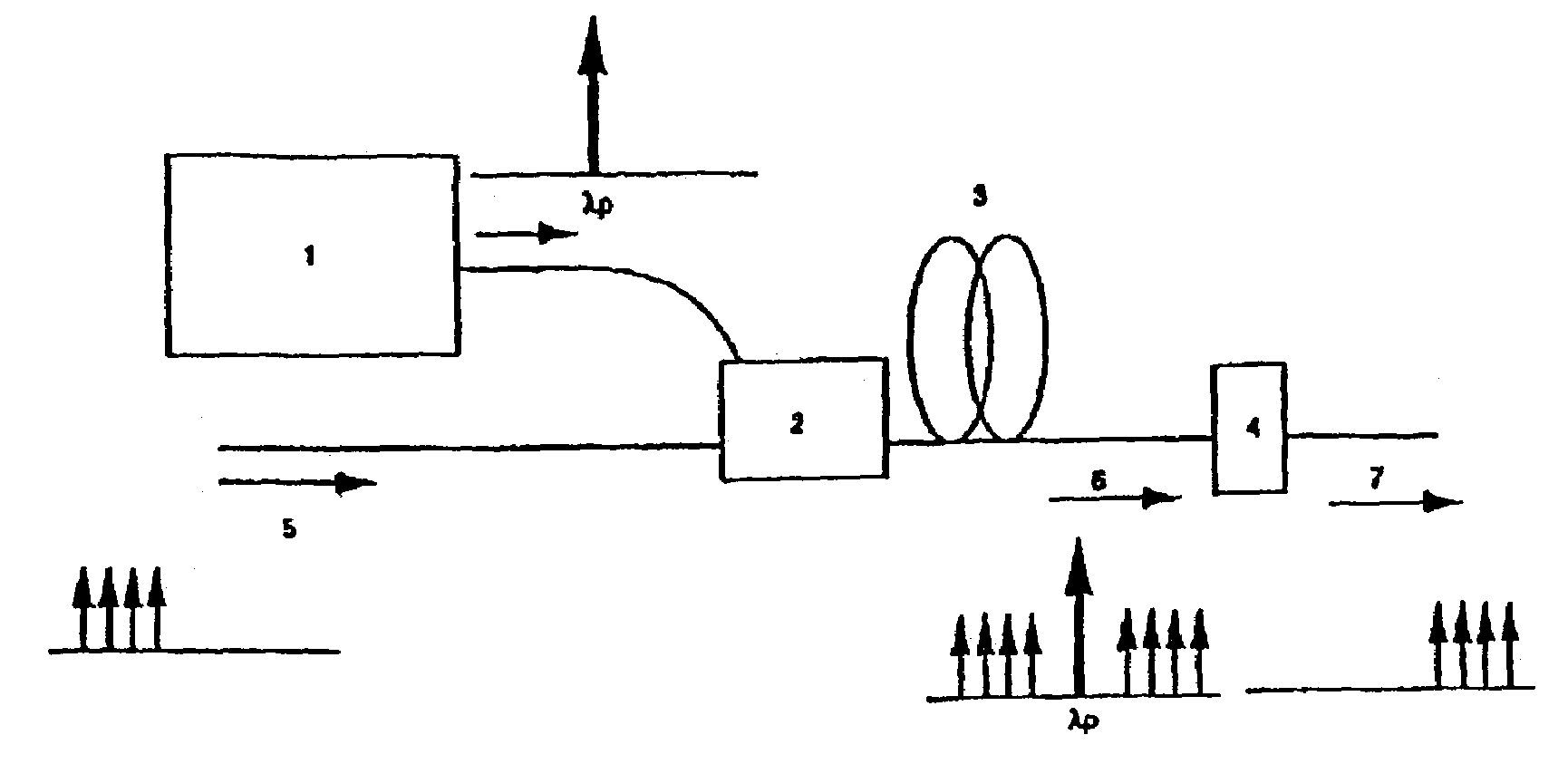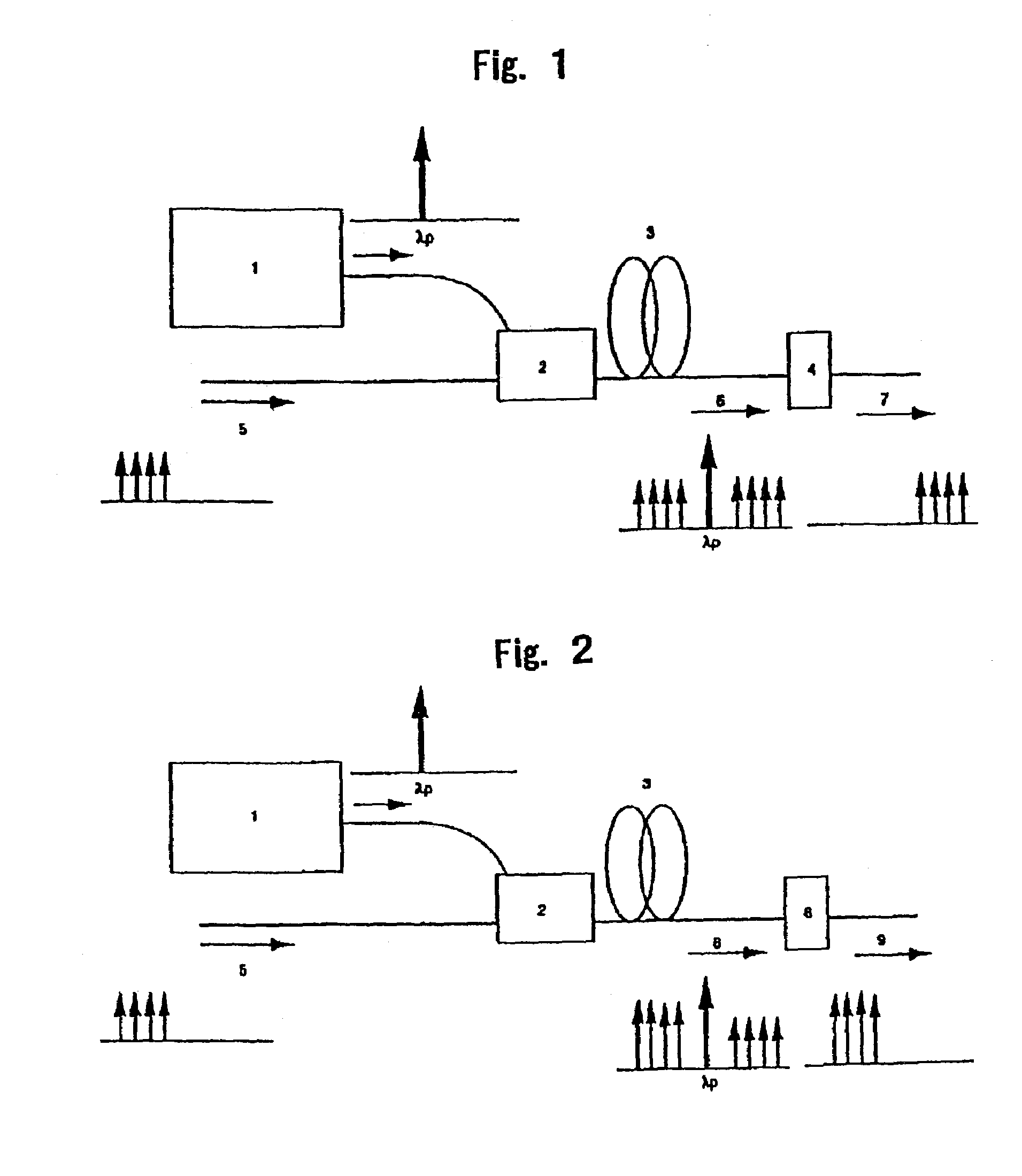Method for efficient four-wave mixing generation and short pulse generation equipment using the method
a four-wave mixing and short-wave technology, applied in multiplex communication, instruments, cladded optical fibres, etc., can solve the problems of inability to allow too intense light to be launched into optical fibers, inability to shorten the length of optical fibers infinitely, and inability to intensify input pumping light without any restriction, etc., to achieve the effect of sufficient efficiency
- Summary
- Abstract
- Description
- Claims
- Application Information
AI Technical Summary
Benefits of technology
Problems solved by technology
Method used
Image
Examples
embodiment 1
[Embodiment 1]
[0072]Embodiment 1 shows a form of a wavelength converter for implementing the present invention. FIG. 1 is a conceptual view showing a conceivable wavelength converter. Pumping light launched into a highly nonlinear optical fiber 3 from a pumping light source 1 is combined with a light signal 5 by an optical combiner 2. This combined light generates idler light in a highly nonlinear optical fiber 3 of which length is optimized. The wavelength of the signal light is converted by the FPM interaction into this idler light. Light 6 on the frequency axis of which all of the signal light, the pumping light, and the idler light are present is emitted from the output end of an optical fiber 3. Accordingly, a wavelength converter can be implemented by filtering the light 6 to obtain only the idler light 7 using an optical filter 4. Incidentally, the idler light 7 and the light signal 5 are phase conjugated, and thus this device serves also as a generator of an optical phase co...
embodiment 2
[Embodiment 2]
[0073]Embodiment 2 shows a form of an optical parametric amplifier for implementing the present invention. FIG. 2 is a conceptual view showing a conceivable optical parametric amplifier. Pumping light launched from a pumping light source 1 is combined with a light signal 5 by an optical combined 2. This combined light generates idler light in a highly nonlinear optical fiber 3 of which length is optimized, while the intensity of the signal light itself is being amplified by the parametric amplification effect. Light 6 on the frequency axis of which all of the amplified signal light, the pumping light, and the idler light are present is emitted from the output end of the optical fiber 3. Accordingly, an optical parametric amplifier can be implemented by filtering the light 6 to obtain only the amplified signal light 9 using an optical filter 8.
embodiment 3
[Embodiment 3]
[0074]Embodiment 3 shows a form of an optical circuit to be used in an optical signal regeneration circuit for implementing the present invention. As described in literature [12], the optical regeneration circuit outputs an optical signal of which waveform is shaped with respect to an input signal light or extracts optical time division multiplexed signals. The optical circuit that constitutes the optical signal regeneration circuit shown in FIG. 2 of the literature [12] comprises, as shown in the specification of the literature [12], a highly nonlinear medium for generating four wave mixing, an optical filter for allowing only the idler light to pass therethrough, and a pumping light source. Therefore, the construction is the same as that of Embodiment 1. In the literature [12], a semiconductor amplifier was used as the highly nonlinear medium. By constituting the optical signal regeneration circuit shown in the literature [12] using the optical circuit of the configu...
PUM
 Login to View More
Login to View More Abstract
Description
Claims
Application Information
 Login to View More
Login to View More - R&D
- Intellectual Property
- Life Sciences
- Materials
- Tech Scout
- Unparalleled Data Quality
- Higher Quality Content
- 60% Fewer Hallucinations
Browse by: Latest US Patents, China's latest patents, Technical Efficacy Thesaurus, Application Domain, Technology Topic, Popular Technical Reports.
© 2025 PatSnap. All rights reserved.Legal|Privacy policy|Modern Slavery Act Transparency Statement|Sitemap|About US| Contact US: help@patsnap.com



